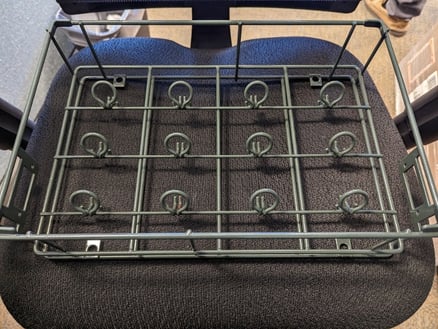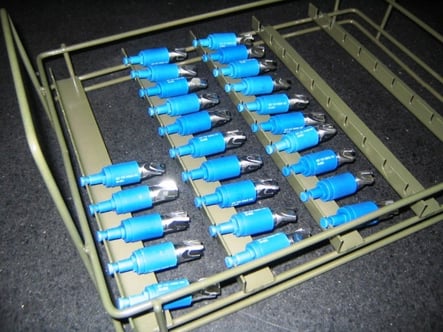When it comes to manufacturing, protective coatings play an essential role in enhancing the longevity and durability of equipment and products. Halar® 6014 and Halar® 6614 are two popular coating options – a resin and a primer, respectively – that offer superior chemical resistance and exceptional mechanical properties. In this blog, we will delve into the differences between these coatings, their typical coating thickness, when to use each of them, what applications they are used for, and why manufacturers should consider investing in precision wire baskets with these coatings.
What Are Halar® 6014 and Halar® 6614?
 Produced by Solvay, Halar® 6014 and Halar® 6614 are high-performance fluoropolymer coatings made from ethylene and chlorotrifluoroethylene (ECTFE) resin. They are known for their excellent chemical resistance, mechanical properties, and barrier protection against extreme temperatures, permeation, flame, and UV radiation. These coatings are commonly used in industrial applications where harsh conditions can cause damage or corrosion to equipment.
Produced by Solvay, Halar® 6014 and Halar® 6614 are high-performance fluoropolymer coatings made from ethylene and chlorotrifluoroethylene (ECTFE) resin. They are known for their excellent chemical resistance, mechanical properties, and barrier protection against extreme temperatures, permeation, flame, and UV radiation. These coatings are commonly used in industrial applications where harsh conditions can cause damage or corrosion to equipment.
Both Halar® 6014 and 6614 are low-VOC (volatile organic compound) materials. They offer high hardness, good adhesion, dielectric properties, and minimal moisture absorption. These coatings have a low coefficient of linear thermal expansion (CLTE) and low thermal flexibility, and they’re sterilizable by heat, steam in an autoclave, radiation, e-beams, and ethylene oxide.
Benefits of Using Halar® 6014 and 6614 on Precision Wire Baskets
Halar® coatings offer several benefits to companies that use wire baskets for industrial processes, including superior chemical resistance, excellent abrasion resistance, and UV resistance. These coatings provide a protective barrier that prevents the substrate from damage caused by corrosive chemicals, making them ideal for harsh industrial environments. Additionally, the coatings offer abrasion resistance, ensuring that the substrate remains intact even when subjected to heavy loads or rough handling. The coatings also offer UV resistance, preventing the substrate from degrading when exposed to sunlight.
Adhesion
Halar® 6014 and 6614 offer good adhesion to various substrates, including metals, plastics, and composites. This means that the coatings will not peel or delaminate from the surface of the baskets, ensuring a long-lasting and durable finish. That said, it is a thick film (0.010”), and the coating film is typically stronger than the adhesive forces. Once the coating is perforated, it's easy to get a tool underneath and lift it up. Watch for perforation as liquids tend to wick under the coating and degrade the adhesion.
Chemical Resistance
Precision wire baskets are used to hold parts or components during various chemical processes. Halar® coatings offer excellent chemical resistance to a wide range of acids, alkalis, and solvents. This means that the baskets coated with Halar® will not degrade or corrode when exposed to harsh chemicals, increasing their lifespan and durability.
Abrasion Resistance
Precision wire baskets are also subjected to wear and tear from repeated use. Halar® coatings offer excellent abrasion resistance, protecting the baskets from damage caused by friction or impact. This means that the baskets coated with Halar® will remain in good condition for longer, reducing the need for frequent replacements.
Temperature Resistance
Precision wire baskets may also be exposed to extreme temperatures during certain industrial processes. Halar® coatings offer excellent temperature resistance, withstanding temperatures ranging from -76° F to 300° F (-60° C to 149° C). This means that the baskets coated with Halar® can be used in a wide range of environments without the risk of melting, cracking, or warping.
Resistance Capabilities: Summary
For a more comprehensive look at what these coatings can withstand, Halar® 6014 and 6614 offer resistance to:
- Abrasion
- Alkalis and acids
- Alcohol
- Creep
- Detergent
- Flame
- Gamma radiation
- High temperatures
- Hydrolysis
- Impact
- Sour gas
- UV light
Marlin Steel’s Customization Capabilities and Coating Application Technique
 Application of Halar® coatings requires heating the substrate to 550° F (preferably 750° F) and should include roughening of the substrate to improve the adhesion of the Halar®. This prevents the application of Halar® to most plastics.
Application of Halar® coatings requires heating the substrate to 550° F (preferably 750° F) and should include roughening of the substrate to improve the adhesion of the Halar®. This prevents the application of Halar® to most plastics.
Marlin Steel can achieve a 10 mil thickness for Halar® coatings on products like wire baskets that have thin sections in their design. The initial coat typically starts at 3 to 4 mils, with the Halar® coating applied electrostatically. Next, the first coat is melted by heating the component in an oven. As it comes out, the coating is now insulative, so we will hot-flock the surface using more powder rather than electrostatics. The part will undergo this process until the coating has reached the desired thickness. It can be time-consuming and costly because, given that thin sections cool rapidly when removed from the heat, the hot-flock can only apply 1 or 2 mils of coating each time without gravity impacting the coating and resulting in runs, drips, or sags. This cycle is repeated until we achieve the targeted coating thickness.
While we typically apply Halar® coatings in thicknesses of 10 mil, with our customization capabilities and expertise, Marlin Steel can achieve a 30 mil maximum upon request for sections that have significant thermal mass, such as wire with a 3/8” diameter or larger. It may be difficult to achieve such a thickness, however, for a large basket.
Differences Between Halar® 6014 and Halar® 6614
While Halar® 6014 and Halar® 6614 share many similarities, there are some differences that make one coating more suitable than the other depending on the specific application.
Halar® 6614 (green), Halar® 6514 (black), and Halar® 6914 (gray) are primers and shouldn't be used without a topcoat of 6014. These three primers are a combination of pigment, ECTFE, and other resins designed to promote adhesion to the part being coated. You apply 6614 utilizing fluidized bed or electrostatic methods. It's a more flexible coating, making it ideal for projects that require flexibility. Halar® 6614 has applications in general industry as well as oil and gas in additives and paints or as a coating for equipment and components.
Halar® 6014, on the other hand, is a more rigid coating, which makes it better suited to applications that require enhanced abrasion resistance. Compatible with electrostatic powder coating application methods, Halar® 6014 (clear) has high purity and a pleasing surface finish. Its resistance capabilities as well as its hardness lend Halar® 6014 to applications as a topcoat. 6014 shouldn't be used without a primer as it would have very poor adhesion and likely separate from the substrate. In addition to 6614’s applications, Halar® 6014 is also useful in the electronics industry for semiconductors.
When to Use Halar® 6014 vs. Halar® 6614
Choosing between Halar® 6014 and Halar® 6614 depends on the specific requirements of the application. Halar® 6014 resin is a better choice for applications that require abrasion resistance, such as wire baskets that hold heavier objects that may cause wear and tear over time. This coating is also used in applications that involve high-purity chemicals, such as the pharmaceutical, food, and beverage industries.
Halar® 6614 primer is an excellent choice for applications that require flexibility, such as wire baskets that hold delicate or irregularly shaped objects. This primer can also be used for coatings on tanks and vessels or process equipment. Solvay prefers the 6614 primer for “chemical service,” but they don't provide any documentation supporting the 6614 over any of the other primers. 6514 and 6914 are the least expensive options, with 6614 being the most expensive.
Why Manufacturers Should Consider Using Halar® Coatings on Precision Wire Baskets
Investing in precision wire baskets with Halar® coatings can offer several benefits. These coatings provide superior chemical and abrasion resistance, protecting the wire baskets from damage caused by corrosive chemicals and heavy loads. Additionally, the coatings offer excellent UV resistance, ensuring that the wire baskets remain intact even when exposed to sunlight. By using precision wire baskets with Halar® coatings, manufacturers can ensure that their products last longer and perform better, ultimately reducing the need for costly repairs or replacements.
Marlin Steel: Your Partner for Customized Wire Baskets
Halar® 6014 and Halar® 6614 are two popular coating options that offer a range of benefits in different applications. By understanding the differences between these coatings and when to use each, manufacturers can choose the coating that is best suited to their specific requirements. Investing in precision wire baskets with these coatings can offer several benefits, including superior chemical and abrasion resistance.
Since 1968, Marlin Steel has offered an extensive line of custom metal baskets, material handling containers, racks, and more. Our team serves industries ranging from automotive and aerospace to medical and telecommunications. As part of our commitment to Quality Engineered Quick®, we offer baskets of superior quality with fast delivery, so that you never have to sacrifice one for the other, even on custom products. We incorporate automation in our processes for faster turnaround and enhanced precision. Our coated wire baskets and other steel wire forms are made fully in the USA.
Our team will work with you to provide the coating thickness you need for your specific application. In addition to Halar® resins and primers, we also offer Niloxy and Teflon™ coatings to meet varied needs. To learn more about our coating options and to discuss the thickness you need, contact us today.


.gif)


